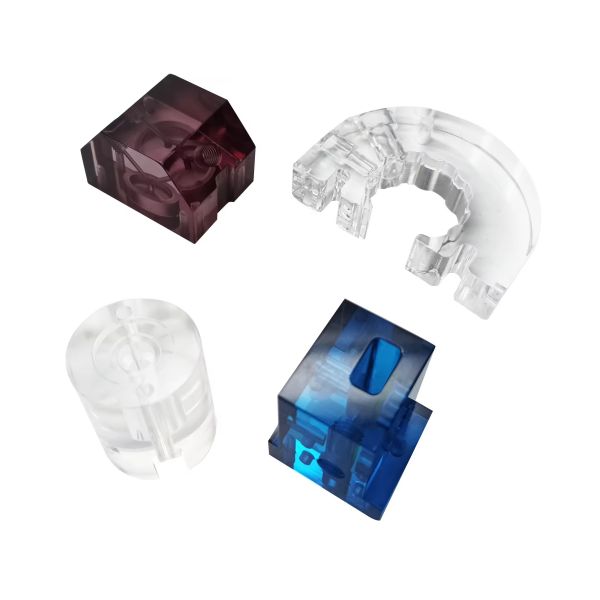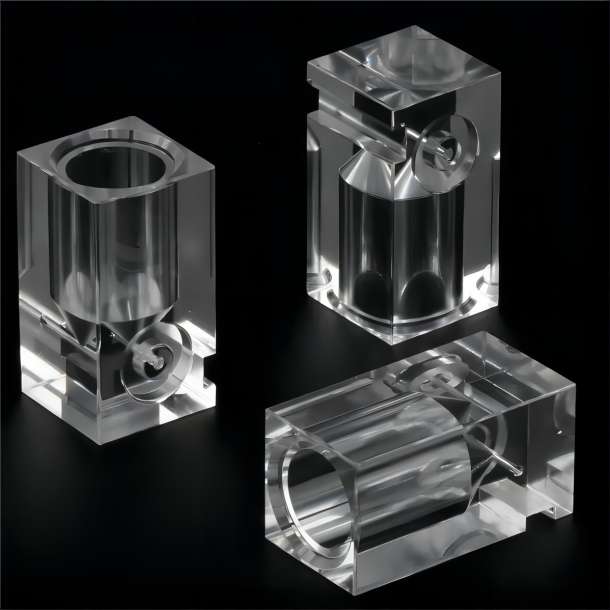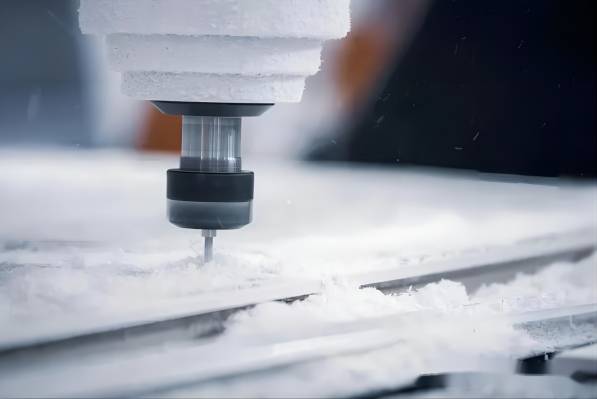
Privacy statement: Your privacy is very important to Us. Our company promises not to disclose your personal information to any external company with out your explicit permission.
acrylic and polycarbonate CNC Machining
General properties and applications of acrylic and polycarbonate, including requirements for CNC machining of acrylic and polycarbonate, and when it is most appropriate to use acrylic or polycarbonate in a particular application.

What is acrylic?
Acrylic, or polymethylmethacrylate (PMMA), is a clear thermoplastic that is commonly used as an alternative to glass. Compared to glass, acrylic is lighter, tougher, and more resistant to UV light. Acrylic's optical clarity makes it ideal for lenses, display cases, aquariums and more.
Acrylic is produced in either cast form or extruded form, with the cast form being more suitable for processing due to its higher melting point and rigidity, albeit at a higher cost. Extruded acrylic is more flexible and better suited to bending or forming operations.
Properties of Acrylic
Here are some key properties of acrylic:
Optical Transparency: Acrylic has excellent optical transparency, with a visible light transmission of up to 92 per cent and a UV light transmission of 72 per cent. In comparison, glass has a light transmission of between 80 and 90 per cent.
Chemical Resistance: Acrylic is resistant to a wide range of chemicals, including inorganic acids, fuels, oils and aliphatic hydrocarbons. However, alcohols and organic solvents can damage acrylic parts, causing them to blur, crack or dissolve.
UV Resistance: Acrylic is not only resistant to reduced UV transmittance, but also to long-term UV radiation exposure. Unlike other transparent plastics such as PVC or unmodified polycarbonate, acrylic does not yellow and maintains its optical clarity when exposed to UV light for extended periods of time.
Lightweight: Acrylic is 50% lighter than glass, making it an ideal glass replacement in weight-sensitive applications.
Easy to scratch: Acrylic is not resistant to scratches and is easily damaged, so acrylic sheets are often coated with a scratch-resistant film. However, this treatment is impractical if the part is CNC machined.
Weak toughness: acrylic is neither particularly tough nor impact resistant. If toughness is required, polycarbonate or other materials are recommended.
When determining the best material to use for acrylic or polycarbonate, the above properties should be considered to ensure adaptation to the needs of the particular application.

What is polycarbonate?
Polycarbonate is a clear, high-strength engineering thermoplastic commonly used in applications that require transparency and toughness. Unlike acrylic, polycarbonate can be flexed to a high degree without cracking.
CNC machined polycarbonate parts, such as eyeglass lenses and diagnostic lab equipment, are used in a variety of applications that rely on their clarity and toughness. If you wear eyeglasses, the lenses are most likely made of polycarbonate, not "glass", and have been since the 1980s.
Properties of Polycarbonate
Polycarbonate stands out for its toughness, workability and heat resistance, however, it is affected by UV radiation and has poor scratch resistance. Here are some of the key properties of polycarbonate:
Optical clarity: polycarbonate has a light transmission rate of 90 per cent, slightly lower than acrylic's 92 per cent but still slightly better than glass. Polycarbonate also blocks UV radiation.
High Toughness: Polycarbonate is a tough material that is highly resistant to impact loads and is able to absorb shocks without breaking. Because of its toughness, polycarbonate is used in bulletproof windows.
Fire Resistant: Polycarbonate is resistant to flame and will not burn when exposed to an open flame, and the material is self-extinguishing, i.e., polycarbonate will not burn when exposed to an open flame and will stop burning when the flame is removed. Specifically, polycarbonate has a flame retardancy rating of B1, which means it is "low" flammable.
Contains BPA(s): Some grades of polycarbonate contain bisphenol A (BPA) and therefore should not be used in food containers; heating polycarbonate accelerates the release of BPA. This chemical has been linked to a number of adverse health effects such as cancer and reproductive damage, but BPA-free variants of polycarbonate are also available (e.g. Tritan).
Poor UV Resistance: Polycarbonate is not resistant to UV radiation, so over time the plastic will yellow and the surface will be damaged by UV radiation. UV stabilisers can be added to polycarbonate to prevent yellowing and brittleness due to UV exposure.
Poor Scratch Resistance: Although polycarbonate is a tough plastic, it is less scratch resistant than acrylic. As a result, it is often necessary to apply a scratch-resistant coating such as silica or titanium dioxide, which can be challenging for geometrically complex parts because of the complexity of the vacuum deposition process.

Machining Acrylic and Polycarbonate
Cutting Tools
When machining acrylic and polycarbonate, it is critical to use sharp cutting tools to limit friction between the tool and the part. Dull drills can cause the plastic to melt due to the heat generated by friction, creating a coating.
Typically, tungsten carbide tools are preferred for thermoplastics, but polycrystalline diamond (PCD) tools give the best results. Upper-cutting helical tools with one or two helical flutes are often the best tools for milling acrylic and polycarbonate because they offer high material removal rates, are very sharp, and do not leave burrs on the machined part. Multi-flute tools can lead to chip build-up in holes and flutes and material adhesion to the cutting tool. For drilling operations, a sharp 135 degree drill angle is preferred.
Clamping
Both polycarbonate and acrylic can warp if clamps are too tight, as it causes the part to bulge during machining. Once removed from the machine, the material will spring back, causing the feature to be out of tolerance. However, when mechanical clamping is not ideal, a vacuum table can hold the material in place. Alternatively, double-sided tape can hold thinner plates in place on the machine, although tape residue can be difficult to remove.
Speed and feed
The exact speeds and feeds for machining polycarbonate and acrylic depend on a number of factors, including the type of machine, the type of part and the fixture. However, polycarbonate and acrylic must be cut at high spindle speeds (up to 18,000 RPM) and high feed rates are also preferred as slow feed rates may melt the material.
Polycarbonate has a higher melting temperature than acrylic, so it is less likely to melt at low speeds and feeds, and sometimes polycarbonate prefers slower feeds. Acrylic tends to chip more easily, while polycarbonate is tougher and does not chip as easily.
Cooling
In most cases, compressed air is sufficient to cool both acrylic and polycarbonate parts during machining. However, much depends on the speed, feed and type of cutting operation. If immersion or atomised cooling is required, use a water-based coolant as coolants containing organic solvents may damage parts, especially acrylic.
Choices in Acrylic vs. Polycarbonate CNC Machining
When choosing acrylic vs. polycarbonate for CNC machining, decisions vary depending on a number of factors. For example, applications requiring increased toughness, higher heat resistance, and good optical clarity are better suited for polycarbonate.
Acrylic is slightly better in terms of optical clarity and is more appropriate for applications where clarity is the primary design factor. Both materials are easy to machine, provided speeds and feeds are relatively high. In some cases, post-processing polishing operations may be required, particularly where optical transparency is desired.
November 17, 2024
November 16, 2024
August 27, 2021
August 26, 2021
PEEK ball is a special type of ball made of polyether ether ketone (PEEK), which has excellent chemical stability, abrasion resistance, and high temperature resistance.PEEK ball is widely used in...
PVDF Application Areas Different models of PVDF products are suitable for different application scenarios. According to application fields, PVDF can be divided into conventional grade products and...
Application Performance Advantages of MC nylon MC nylon is a new type of engineering plastics, due to its outstanding comprehensive performance, so that its status in engineering plastics is rapidly...
Types of nylon: 1. Nylon - 6 (PA6) Nylon -6, also known as polyamide -6, that is, polycaprolactam. Translucent or opaque opalescent resin. 2. Nylon - 66 (PA66) Nylon-66, also known as polyamide-66,...
Email to this supplier
November 17, 2024
November 16, 2024
August 27, 2021
August 26, 2021

Privacy statement: Your privacy is very important to Us. Our company promises not to disclose your personal information to any external company with out your explicit permission.

Fill in more information so that we can get in touch with you faster
Privacy statement: Your privacy is very important to Us. Our company promises not to disclose your personal information to any external company with out your explicit permission.